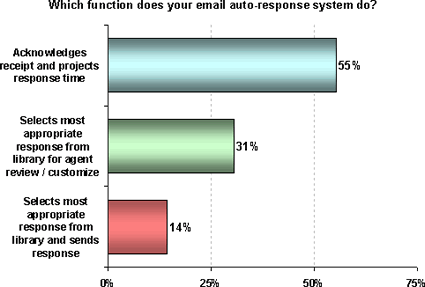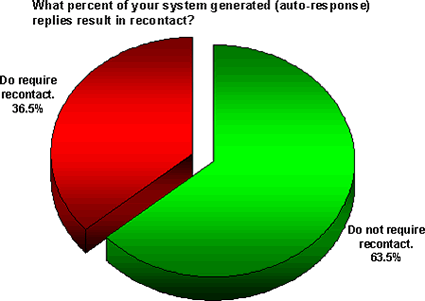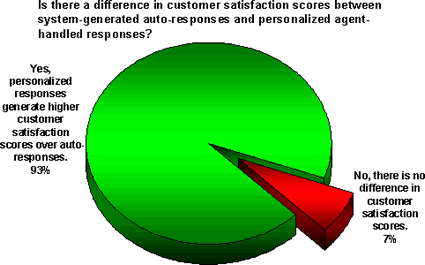|
In today’s fast paced world, everyone is looking for shortcuts, especially when contacting a company for needed help or information. We’d all like to be able to get what we want at any time of any day, when we need it.
We all know that calling a 1-800 number presents the risk of encountering complicated, confusing, and time-consuming voice-response systems that may or may not lead us to the help or information we are seeking, or put us into a hold queue while being informed that our call “will be handled by the next available agent,” that “all agents are presently serving other customers,” and that “expected wait time will be fifteen minutes (or more).” Or worse, we may find that the call center is closed until the next business day.
Our reaction? Frustration, aggravation and dissatisfaction!
To resolve this dilemma for both companies and their customers, most companies now offer e-mail as an alternative contact channel, or shortcut, for customer service and support. In a recent survey of over 888 contact center managers, we found that over 93% of the companies surveyed offer e-mail as a contact channel.
When asked, “Do you use an automated e-mail management system to generate a response to your customers,” slightly more than half, or 51%, of the managers indicated that their contact center uses an auto-response system to handle customer service e-mail.
Well, then, it sounds like they’ve solved the problems of unlimited customer access and rapid response, right? Not necessarily.
The key issues are these:
- What kind of response(s) does their automated e-mail management system generate?
- Does the automated response resolve the customer’s need without requiring re-contact?
- How satisfied is the customer with the response received?
Of the companies reporting that they use an automated e-mail response system for customer service, the types of response functions their system generates are shown in figure 1, along with the percentage of each response function used:

©Purdue University/BenchmarkPortal, Inc.
Figure 1: Response functions of automated e-mail management systems in use.
As Figure 1 illustrates, more than half of the e-mail auto-response systems merely acknowledge receipt of their customer’s e-mail message and project a response time, and only 14% generate and send a (hopefully) appropriate response.
About one-third of the contact centers surveyed are actually semi-automated where pre-selected e-mail responses are forwarded to an agent to review and customize before responding, which introduces a delay factor into the response time that depends upon agent availability and backlog. Sound familiar?
Next, our survey took a look at the percentage of e-mail auto-responses that forced the customer to re-contact the company for the same issue again. Figure 2 depicts the results:

©Purdue University/BenchmarkPortal, Inc.
Figure 2. Automated e-mail responses requiring re-contact by the customer.
Of the e-mail auto-responses generated by contact centers, over one-third required customers to re-contact their contact center to resolve the initial issue, in some cases multiple times. Comparing this metric to call centers using a first-time-final metric of 90% for calls resolved, one would find the reported results disappointing, and perhaps indicative of a need to apply the same first-time-final key performance metric to e-mail contacts that they use for phone contacts.

©Purdue University/BenchmarkPortal, Inc.
Figure 3. Is there a difference in customer satisfaction scores between system-generated auto-responses and personalized agent-handled responses?
Finally, our survey asked contact center managers whether they noticed a difference in customer satisfaction scores between system-generated e-mail auto-responses and personalized agent-handled responses. Their responses, as shown in Figure 3, indicate an overwhelming customer preference for personalized agent-handled e-mail responses over system-generated e-mail auto-responses.
The primary goals for contact centers using automated e-mail management systems are to reduce labor costs, increase accessibility, and improve customer satisfaction. It is laudable that companies have opened up an e-mail contact channel for consumers to access at any time of their choosing, and to answer many of their frequently asked questions.
Properly implemented, an automated e-mail management system will streamline e-mail handling and lower e-mail handling costs. However, companies should not assume that deploying an automated e-mail management system to handle their customer e-mail communication without personalized agent intervention would produce the level of customer satisfaction they hope for.
Best practices for automated e-mail management should include the following:
- Acknowledgement of e-mail receipt and projected response time.
- An extensive library of auto-responses to most commonly asked questions.
- Personalized agent intervention for all but the simplest contacts.
- Tracking of re-contact rate and causes.
- Customer satisfaction measurement as a part of every response.
- Feedback of customer satisfaction survey responses and re-contact causes into training and improvement initiatives.
Ultimately, automated e-mail management systems can be either a boon to a company’s customer service offering that attracts customers to use more products and services, or a bane that fails to satisfy customer needs and drives them to competitors. It all depends upon how well its implementation is driven by goals aimed at improving the customers contact experience.
There are no shortcuts to achieving customer satisfaction.
Your Next Step
To gain valuable insight into the current operations of your call center, try taking the free RealityCheck™. After you complete an 11-question survey, we compare your call center's performance to others in your industry and rank your center in both efficiency and effectiveness -- you get results immediately after submitting your data online. Get started today at http://www.BenchmarkPortal.com.
Dr. Jon Anton is director of Benchmark Research at Purdue University’s Center for Customer-Driven Quality. He has published 22 books and 96 papers on customer service and call center methods. Dr. Jon can be reached at: [email protected].
About BenchmarkPortal Inc.: BenchmarkPortal Inc., founded by Dr. Jon Anton, manages the largest database of key performance indicators (KPIs) collected from thousands of customer service contact centers in 43 different industries, and from 28 countries worldwide. Detailed reports of this data are available to call center professionals, enabling them to make intelligent, fact-based management decisions regarding best practices, and to compare their contact center’s performance to a peer group of similar call centers. For more information about BenchmarkPortal, call 805.614.0123 or visit: http://www.BenchmarkPortal.com.
|